#Frontline PBS
Explore tagged Tumblr posts
Text
oh also FYI there's a lot of PBS documentaries on youtube for free uploaded by pbs themselves. nova, american experience, frontline--it's there!
4 notes
·
View notes
Text

Left Behind America Shimon Dotan USA, 2018
0 notes
Text
youtube
from January 23rd, 2024, from Frontline PBS
0 notes
Text
Interested in learning more about plastic pollution and the needed actions? Scan the QR code below for a documentary you can watch!

0 notes
Text
youtube
For those looking to donate to help Ukraine, here is a list of highly recommended Charities/Organizations:
I also recommend Save Ukraine. They work to rescue Ukrainian children who have been kidnapped and deported to Russia since the start of the war. This video, Stealing Ukraine's Children: Inside Russia's Camps, gives more insight into that particular situation:
youtube
On a final note, U.S. Congress needs to pass the $60 billion in aid to Ukraine. Shame on Republicans for holding this up! That is unacceptable and reprehensible on so many levels.
#20 days in mariupol#ukraine#stealing ukraine's children: inside russian camps#russian invasion of ukraine#russian war in ukraine#war in ukraine#russia is a terrorist state#fuck russian fascist occupiers#donations#signal boost#tgh opinions#social issues#Youtube#stand with ukraine#support ukraine#slava ukraini#vice news#pbs frontline
73 notes
·
View notes
Text
youtube
The Oscar for best documentary feature went to 20 Days in Mariupol. It documents the horrors of Russian war crimes in the early stages of Putin's illegal invasion of Ukraine.
Rather than have me tell you about it, you can watch the entire film right here.
youtube
If you live in a Congressional district represented by a Republican, contact him/her and describe the contents of the documentary. And ask: Why are you helping Putin commit war crimes?
Not sure who represents you? Use your ZIP+4 to find out here…
Find Your Representative
You'll find contact info at your Rep's site.
#invasion of ukraine#UkraineAidNow#oscars#academy awards#best documentary feature#stand with ukraine#20 days in mariupol#pbs frontline#ap#mstyslav chernov#evgeniy maloletka#vasilisa stepanenko#michelle mizner#derl mccrudden#raney aronson#mariupol#vladimir putin#genocide#20 днів у маріуполі#мстислав чернов#євгеній малолєтка#василиса степаненко#маріуполь#вторгнення оркостану в україну#геноцид#военные преступления#владимир путин#путин хуйло#добей путина#слава україні!
17 notes
·
View notes
Text
Do you guys think Nancy and Jonathan watch PBS Frontline together?
#the real reason she needs to home on Tuesdays#ugh them in a when Harry met Sally phone scene but they're watching Frontline#“they wouldn't watch PBS” Nancy wants to be a journalist and Jonathan loves PBS#it's part of his old man nonsense#also he'd LOVE being pretentious about watching PBS#i know this#jancy#nancy wheeler#jonathan byers
10 notes
·
View notes
Text
#Kakistocracy #CorpMedia #Idiocracy #Oligarchs #MegaBanks vs #Union #Occupy #NoDAPL #BLM #SDF #DACA #MeToo #Humanity #DemExit #FeelTheBern
TONIGHT 10E/9C ON PBS - 20 Days in Mariupol
An AP team of Ukrainian journalists trapped in the besieged city of Mariupol struggle to continue their work documenting atrocities of the Russian invasion. As the only international reporters who remain in the city as Russian forces close in, they capture what become some of the most defining images of the war: dying children, mass graves, the bombing of a maternity hospital, and more...
#Kakistocracy#CorpMedia#Idiocracy#Oligarchs#MegaBanks vs#Union#Occupy#NoDAPL#BLM#SDF#DACA#MeToo#Humanity#DemExit#FeelTheBern#TONIGHT 10E/9C ON PBS - 20 Days in Mariupol#https://www.pbs.org/wgbh/frontline/documentary/20-days-in-mariupol/#An AP team of Ukrainian journalists trapped in the besieged city of Mariupol struggle to continue their work documenting atrocities of the#they capture what become some of the most defining images of the war: dying children#mass graves#the bombing of a maternity hospital#and more...
26 notes
·
View notes
Text
For viewers in Canada, Puerto Rico, and the United States, the film is available here (needless to say, the film contains graphic war imagery not suitable for all audiences):
youtube


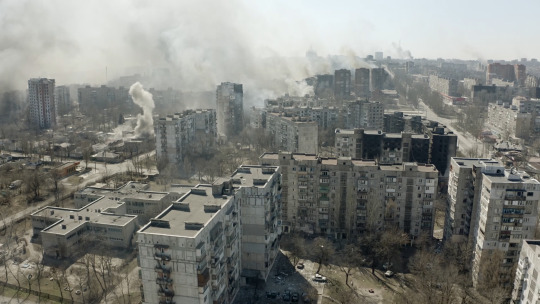
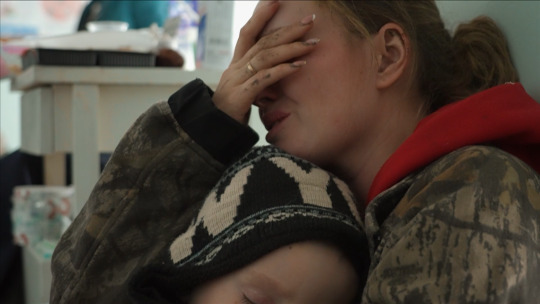


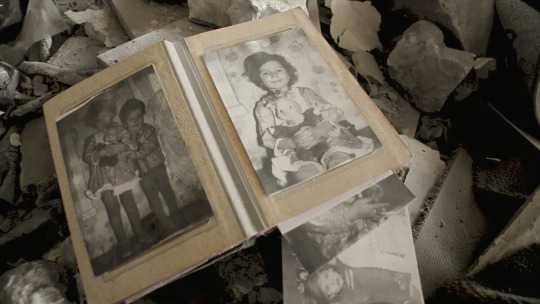
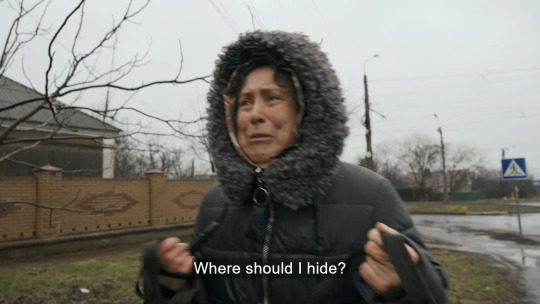


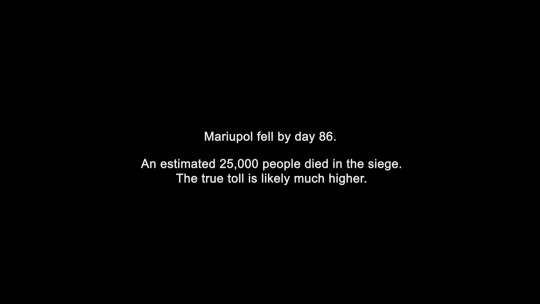
20 Days in Mariupol (Mstyslav Chernov, 2023)
"An emotionally devastating account of the inhumanity of war."
"Documentary film-making rarely gets more impactful and devastating than this personalised account of life inside the southern Ukrainian city of Mariupol at the start of last year’s Russian invasion."
#20 Days in Mariupol#Mstyslav Chernov#Russo Ukrainian War#Ukraine#Russia#Associated Press#PBS#Frontline#31 Days of Oscar
1K notes
·
View notes
Text
Breakdown in Maine (2024)
youtube
An investigation into the breakdowns with police, military and mental health care in the lead-up to what became the deadliest mass shooting in Maine’s history.
0 notes
Text
The Roy Cohn Playbook | Donald Trump | The Choice 2024 Shorts
youtube
0 notes
Text

Documenting Police Use of Force Serginho Roosblad USA, 2024
#Documenting Police Use of Force#Serginho Roosblad#2024#2020s#documentary#title card#youtube#Frontline PBS#PBS
0 notes
Text
Here's a link to the entire video:
youtube
This is okay. You will learn a few things about Harris and Trump that you didn't know. You'll really understand what makes Trump & Hatris tick and how they acquired their skills. l
However, it's very disappointing that PBS left out Trump’s statements regarding being a dictator, Project 2025, and his plans to round-up immigrants. All of it speaks to Hitler-like plans from Trump.
I will never understand the media's need to soften Trump in order to be "fair" to a man who has *never* been fair or even honest. This decency is what sociopaths have learned makes people easy prey.
A Trump victory will not be just another Republican victory. It will be the end of democracy for the foreseeable future in the United States.
It's absolutely certain that many of the voters do not understand that choice. Even some journalists do not understand that, which is stunning. It's is their job to know. It's their job to draw parallels to history. Just because we've never had a totalitarian leader before in America does not mean we couldn't elect one this November. Other countries have made the mistake of willingly handing power to cruel and ruthless leader countless times.
"It can't happen here," is just denial of our stark reality in 2024.
We in America are not immune to making the tragic choice of electing a dictator. Even Trump supporters will eventually come to regret that choice when they are living in poverty at the mercy of oligarchs who have no mercy. They will come to understand that Trump was never on their side all along and that he played Americans for suckers for his own ego and financial gain.
0 notes
Text
September 20, 2024

Frontline (1983):
SEASON 44 PREMIERES TODAY!
GENRES: Documentary, News, Talk Show
NETWORK: PBS
Description: Since it began in 1983, Frontline has been airing public-affairs documentaries that explore a wide scope of the complex human experience. Frontline's goal is to extend the impact of the documentary beyond its initial broadcast by serving as a catalyst for change.
0 notes
Text
This documentary by PBS shows how the "less-lethal force" officers are often trained to use leads to deaths across the country, highlights the lack of appropriate training, and shows how mental health episodes are escalated into deadly scenarios by officers.
#the one that really gets me is the one where the officer is calm and clearly follows the training he's been given ._.#like. it's just so clear in that situation that the route training of police officers is flawed and influences deaths#like he literally followed his training to the book. and the man still died. like... that's so fucked#police brutality#pbs news#frontline#documentary#violence#death#death in police custody
0 notes
Text
Why Did More Than 1,000 People Die After Police Subdued Them With Force That Isn’t Meant To Kill?
— In Partnership With: Associated Press (AP)
— March 28, 2024 | Frontline | NOBA — PBS
— By Reese Dunklin | Ryan J. Foley | Jeff Martin | Jennifer McDermott | Holbrook Mohr | John Seewer
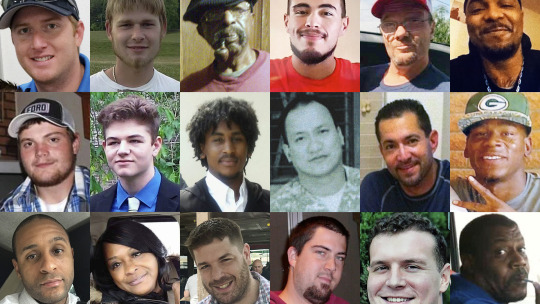
This combination of photos shows, top row from left, Anthony Timpa, Austin Hunter Turner, Carl Grant, Damien Alvarado, Delbert McNiel and Demetrio Jackson; second row from left, Drew Edwards, Evan Terhune, Giovani Berne, Glenn Ybanez, Ivan Gutzalenko and Mario Clark; bottom row from left, Michael Guillory, Robbin McNeely, Seth Lucas, Steven Bradley Beasley, Taylor Ware and Terrell "Al" Clark. Each died after separate encounters with police in which officers used force that is not supposed to be deadly. (AP Photo)
Carl Grant, a Vietnam veteran with dementia, wandered out of a hospital room to charge a cellphone he imagined he had. When he wouldn’t sit still, the police officer escorting Grant body-slammed him, ricocheting the patient’s head off the floor.
Taylor Ware, a former Marine and aspiring college student, walked the grassy grounds of an interstate rest stop trying to shake the voices in his head. After Ware ran from an officer, he was attacked by a police dog, jolted by a stun gun, pinned on the ground and injected with a sedative.
And Donald Ivy Jr., a former three-sport athlete, left an ATM alone one night when officers sized him up as suspicious and tried to detain him. Ivy took off, and police tackled and shocked him with a stun gun, belted him with batons and held him facedown.
Each man was unarmed. Each was not a threat to public safety. And despite that, each died after police used a kind of force that is not supposed to be deadly — and can be much easier to hide than the blast of an officer’s gun.
Every day, police rely on common tactics that, unlike guns, are meant to stop people without killing them, such as physical holds, Tasers and body blows. But when misused, these tactics can still end in death — as happened with George Floyd in 2020, sparking a national reckoning over policing. And while that encounter was caught on video, capturing Floyd’s last words of “I can’t breathe,” many others throughout the United States have escaped notice.
Over a decade, more than 1,000 people died after police subdued them through means not intended to be lethal, an investigation led by The Associated Press found. In hundreds of cases, officers weren’t taught or didn’t follow best safety practices for physical force and weapons, creating a recipe for death.
This story is part of an ongoing investigation led by The Associated Press in collaboration with the Howard Center for Investigative Journalism programs and FRONTLINE (PBS). The investigation includes the Lethal Restraint interactive story, database and the documentary, Documenting Police Use Of Force, premiering April 30 on PBS.
These sorts of deadly encounters happened just about everywhere, according to an analysis of a database AP created. Big cities, suburbs and rural America. Red states and blue states. Restaurants, assisted-living centers and, most commonly, in or near the homes of those who died. The deceased came from all walks of life — a poet, a nurse, a saxophone player in a mariachi band, a truck driver, a sales director, a rodeo clown and even a few off-duty law enforcement officers.
Explore: Lethal Restraint
The toll, however, disproportionately fell on Black Americans like Grant and Ivy. Black people made up a third of those who died despite representing only 12% of the U.S. population. Others feeling the brunt were impaired by a medical, mental health or drug emergency, a group particularly susceptible to force even when lightly applied.
“We were robbed,” said Carl Grant’s sister, Kathy Jenkins, whose anger has not subsided four years later. “It’s like somebody went in your house and just took something, and you were violated.”
AP’s three-year investigation was done in collaboration with the Howard Center for Investigative Journalism programs at the University of Maryland and Arizona State University, and FRONTLINE (PBS). The AP and its partners focused on local police, sheriff’s deputies and other officers patrolling the streets or responding to dispatch calls. Reporters filed nearly 7,000 requests for government documents and body-camera footage, receiving more than 700 autopsy reports or death certificates, and uncovering video in at least four dozen cases that has never been published or widely distributed.
Medical officials cited law enforcement as causing or contributing to about half of the deaths. In many others, significant police force went unmentioned and drugs or preexisting health conditions were blamed instead.
Video in a few dozen cases showed some officers mocked people as they died, laughing or making comments such as “sweaty little hog,” “screaming like a little girl” and “lazy f—.” In other cases, officers expressed clear concern for the people they were subduing.
The federal government has struggled for years to count deaths following what police call “less-lethal force,” and the little information it collects is often kept from the public and highly incomplete at best. No more than a third of the cases the AP identified are listed in federal mortality data as involving law enforcement at all.
When force came, it could be sudden and extreme, the AP investigation found. Other times, the force was minimal, and yet the people nevertheless died, sometimes from a drug overdose or a combination of factors.
In about 30% of the cases, police were intervening to stop people who were injuring others or who posed a threat of danger. But roughly 25% of those who died were not harming anyone or, at most, were committing low-level infractions or causing minor disturbances, AP’s review of cases shows. The rest involved other nonviolent situations with people who, police said, were trying to resist arrest or flee.
A Texas man loitering outside a convenience store who resisted going to jail was shocked up to 11 times with a Taser and restrained facedown for nearly 22 minutes — more than twice as long as George Floyd, previously unreported video shows. After a California man turned silent during questioning, he was grabbed, dogpiled by seven officers, shocked five times with a Taser, wrapped in a restraint contraption and injected with a sedative by a medic despite complaining “I can’t breathe.” And a Michigan teen was speeding an all-terrain vehicle down a city street when a state trooper sent volts of excruciating electricity from a Taser through him, and he crashed.
In hundreds of cases, officers repeated errors that experts and trainers have spent years trying to eliminate — perhaps none more prevalent than how they held someone facedown in what is known as prone restraint.
Many policing experts agree that someone can stop breathing if pinned on their chest for too long or with too much weight, and the Department of Justice has issued warnings to that effect since 1995. But with no standard national rules, what police are taught is often left to the states and individual departments. In dozens of cases, officers disregarded people who told them they were struggling for air or even about to die, often uttering the words, “I can’t breathe.”
What followed deadly encounters revealed how the broader justice system frequently works to shield police from scrutiny, often leaving families to grieve without knowing what really happened.
Officers were usually cleared by their departments in internal investigations. Some had a history of violence and a few were involved in multiple restraint deaths. Local and state authorities that investigate deaths also withheld information and in some cases omitted potentially damaging details from reports.
One of the last hopes for accountability from inside the system — what are known as death opinions — also often exonerated officers. The medical examiners and coroners who decide on these did not link hundreds of the deaths to force, but instead to accidents, drug use or preexisting health problems, sometimes relying on debunked science or incomplete studies from sources tied to law enforcement.
Even when these deaths receive the homicide label that fatal police shootings often get, prosecutors rarely pursue officers. Charging police is politically sensitive and can be legally fraught, and the AP investigation identified just 28 deaths that led to such charges. Finding accountability through civil courts was also tough for families, but at least 168 cases ended in settlements or jury verdicts totaling about $374 million.
The known fatalities still averaged just two a week — a tiny fraction of the total contacts police have with the population. Police leaders, officers and experts say law enforcement shouldn’t bear all the blame. As the social safety net frays, people under mental distress or who use stimulant drugs like cocaine or methamphetamine are increasingly on the streets. Officers sent to handle these emergencies are often poorly trained by their departments.
If incidents turn chaotic and officers make split-second decisions to use force, “people do die,” said Peter Moskos, a professor at John Jay College of Criminal Justice and former Baltimore police officer.
“The only way to get down to zero is to get rid of policing,” Moskos said, “and that’s not going to save lives either.”
But because the United States has no clear idea how many people die like this and why, holding police accountable and making meaningful reforms will remain difficult, said Dr. Roger Mitchell Jr., a leader in the push to improve tracking and one of the nation’s few Black chief medical examiners when he held the office in Washington, D.C., from 2014 to 2021.
“Any time anyone dies before their day in court, or dies in an environment where the federal government or the local government’s job is to take care of you,” he said, “it needs transparency. It cannot be in the dark of night.”
“This,” he added, “is an American problem we need to solve.”
Those Who Died
Carl Grant didn’t care much for football. So on Super Bowl Sunday in 2020, family members said, he eased into his black Kia Optima, intending to shop for groceries near his suburban Atlanta home. The 68-year-old wound up 2½ hours away, where he came face to face with police in an encounter that underscores several findings central to AP’s investigation: He was Black, he was not threatening physical harm, and a seemingly routine matter rapidly escalated.
The former Marine and trucking business owner had dementia and qualified as a disabled veteran. As he drove that evening, he became disoriented and took an interstate west to Birmingham, Alabama. There, Grant twice tried to go inside houses he thought were his.
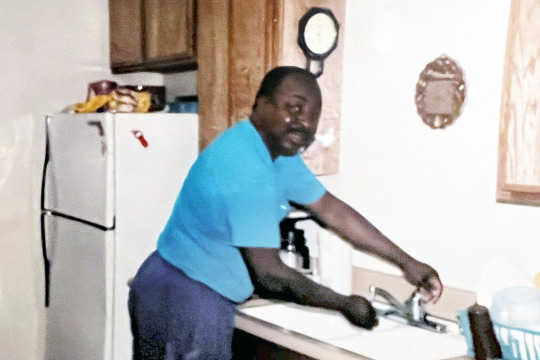
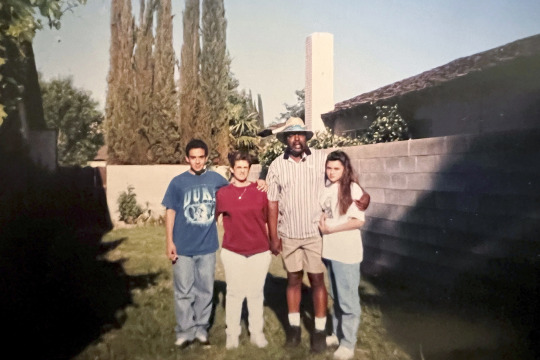
In the family photo on the left, Carl Grant prepares to cook in the home he shared with his partner, Ronda Hernandez, in Redlands, Calif., circa 2000. The family photo on the right shows Carl Grant and his partner, Ronda Hernandez, and her children, Michael and Michelle, in a friend’s backyard in California in the mid-1990s. (Family Photo via AP; Ronda Hernandez via AP)
Both times, residents phoned 911. And both times, responding officers opted to use force.
At the first house, Grant was taken to the ground and cuffed after an officer said he’d stepped toward a partner. Even though one officer sensed he was impaired, police released Grant without asking medics to examine him — a decision a superior later faulted.
At a second house about a half-mile away, police found him sitting in a porch chair. When he didn’t follow an order to get off the porch, a different officer pushed him down the stairs, according to previously unreleased body-camera video. Grant gashed his forehead in the fall.
Officer Vincent Larry, who pushed Grant, went with him to the hospital. When Grant wouldn’t return to his exam room, Larry used an unapproved “hip toss” to lift and slam him, hospital surveillance video showed. The back of Grant’s head bounced four inches off the floor, a nurse estimated, wrecking his spinal cord in his neck.
After Grant awoke from emergency surgery, he thought his paralysis was a combat injury from the Vietnam War. “I’m so sorry this happened,” he told family, his sister recalled. He died almost six months later from the injury.
An internal investigation concluded Larry’s force at the hospital was excessive, and in a departure from many other cases AP found, his department acted: he received a 15-day suspension. He is no longer a city employee, a Birmingham spokesperson told AP. Neither Larry nor the department would comment. A judge recently cited a procedural error in dismissing a lawsuit filed by Grant’s estate, which is appealing the ruling.
“He’s almost 70 and confused,” Grant’s partner, Ronda Hernandez, said. “That’s what I don’t get. You just don’t do that to old people.”
Grant was one of 1,036 deaths from 2012 through 2021 that AP logged. That is certainly an undercount, because many departments blocked access to information. Files that others released were blacked out and video blurred, while officers routinely used vague language in their reports that glossed over force.
All but 3% of the dead were men. They tended to be in their 30s and 40s, when police might consider them more of a physical threat. The youngest was just 15, the oldest 95.
In sheer numbers, white people of non-Hispanic descent were the largest group, making up more than 40% of cases. Hispanics were just under 20% of those killed. But Black Americans were hit especially hard.
The disproportionate representation of Black people tracks research findings that they face higher rates and severity of force, and even deaths. The Department of Justice has found after multiple investigations that Black people accounted for more unjustified stops for minor offenses, illegal searches that produced no contraband, unnecessary force, or arrests without probable cause.
Researchers caution that proving — or disproving — discrimination can be hard because of a lack of information. But in some cases AP identified, officers were accused of profiling and stopping Black people based on suspicions, as happened to Donald “Dontay” Ivy Jr.
A demonstrator holds a sign in support of Donald "Dontay" Ivy during a rally outside Albany District Attorney David Soares' office in Albany, N.Y., on Monday, Aug. 10, 2015. Ivy was cooperative when police stopped him, but, they said, he wouldn’t answer how much money he had withdrawn from an ATM and denied a prior arrest. Police interpreted Ivy’s behavior as deceptive. What they didn’t grasp was that Ivy suffered from paranoid schizophrenia. After an officer touched Ivy to detain him, Ivy fled. Officers caught up and beat him with batons, shocked him several times with a Taser, put him facedown and got on top of him.
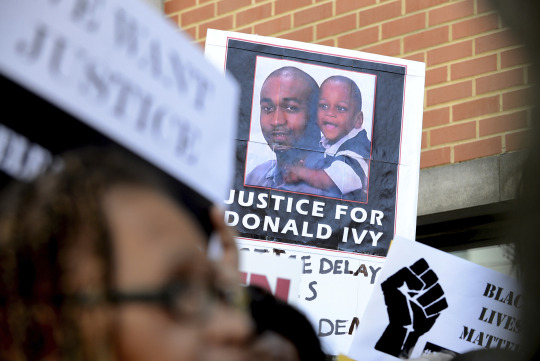
A demonstrator holds a sign in support of Donald “Dontay” Ivy Jr. during a rally outside Albany District Attorney David Soares’ office in Albany, N.Y., on Monday, Aug. 10, 2015. (Will Waldron/The Albany Times Union via AP)
Ivy was a 39-year-old resident of Albany, New York, who excelled in basketball during high school, served in the U.S. Navy and graduated college with a business degree. On a freezing night in 2015, he went to an ATM to check whether a delayed disability deposit had posted. Officers thought he seemed suspicious because he was walking with a lean and only one hand in the pocket of his “puffer” coat — indications, they thought, he might have a gun or drugs.
Ivy was cooperative when they stopped him, but, they said, he wouldn’t answer how much money he had withdrawn and denied a prior arrest. Police interpreted Ivy’s behavior as deceptive without grasping that Ivy suffered from paranoid schizophrenia. A witness recounted that Ivy seemed “slow” when he spoke.
When an officer touched Ivy to detain him — a known trigger for some with severe mental illness — police say Ivy began to resist. An officer fired a Taser, then Ivy fled. Officers caught up and beat him with batons, shocked him several more times with a Taser, put him facedown and got on top of him. By the time they rolled Ivy over, he’d stopped breathing.
The department quickly ruled that the officers acted appropriately and blamed a “medical crisis” for his death, even though it was classified a homicide. A grand jury declined to indict. However, the local prosecutor urged police to review policies for Tasers, batons and dealing with people with mental illness.
The local chapter of the New York Civil Liberties Union continued to question the stop, saying there was “strong reason to suspect” Ivy was racially profiled. After years in court, the city paid $625,000 to settle with Ivy’s estate. His cousin and close friend Chamberlain Guthrie said the way Ivy’s life ended was one of the most painful things his family had endured.
“It’d be one thing if Dontay was out here being a ruffian and he was a thug,” Guthrie said. “But he was none of that.”
When Force Goes Wrong
When people died after police subdued them, it was often because officers went too fast, too hard or for too long — many times, all of the above.
The United States has no national rules for how exactly to apply force. Instead, Supreme Court decisions set broad guard rails that weigh force as either “objectively reasonable” or “excessive,” based in part on the severity of the situation, any immediate safety threat and active resistance.
That frequently leaves states and local law enforcement to sort out the particulars in training and policies. Best practices from the government and private law enforcement organizations have tried to fill gaps, but aren’t mandatory and sometimes go ignored, as happened in hundreds of cases reviewed by AP and its partners.
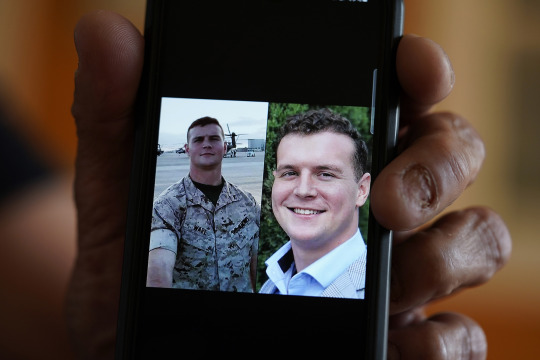
Tom Ware holds photos of his son, Taylor Ware, on his phone in Kansas City, Mo., Tuesday, June 6, 2023. The aspiring college student and former Marine died after a violent encounter with police during a manic episode caused by bipolar disorder. (AP Photo/Charlie Riedel)
In 2019, the mother of Taylor Ware, the former Marine with college plans, called 911 when he wouldn’t get back in their SUV during a manic episode caused by bipolar disorder. She told the dispatcher Ware would need space and urged police to wait for backup because he was a former wrestler and might be a handful — advice that tracked best practices, yet wasn’t followed.
The first officer to encounter Ware at a highway rest stop in Indiana saw the 24-year-old extending him a hand in greeting. Ware then calmly walked through a grassy field and sat down with folded legs.
The officer, an unpaid reserve marshal, assured Ware’s mother he’d had calls like this before. As she and a family friend watched, he stopped about 10 feet in front of Ware, according to video filmed by the friend and obtained by AP. His police dog barked and lunged several times — a provocation officers are told to avoid with the emotionally distressed. Ware remained seated.
After a few minutes, Ware walked toward the parking lot. There, the officer said, Ware pushed him away, a split-second act disputed by the friend. Her video shows Ware running and the officer commanding the dog to attack, setting off a cascade of force that ended with Ware in a coma. He died three days later.

In the left-hand image from video provided by a family friend, Taylor Ware, left, sits in a field approached by a police officer and canine at a highway rest stop in Dale, Ind., on August 25, 2019. In the right-hand image, Ware is restrained by law enforcement and emergency medical personnel. (Pauline Engel via AP)
A police news release said Ware had a “medical event,” an explanation that echoes how police first described George Floyd’s death. The prosecutor in Indiana declined to bring charges and praised officers for “incredible patience and restraint.” His office’s letter brushed past or left out key details: multiple dog bites, multiple stun-gun shocks, prone restraint and an injection of the powerful sedative ketamine.
In dozens of other cases identified by AP, people who died were given sedatives without consent, sometimes after officers urged paramedics to use them — a recommendation law enforcement is unqualified to make.
A coroner ruled Ware’s death was due to natural causes, specifically “excited delirium” — a term for a condition that police say causes potentially life-threatening agitation, rapid heart rate and other symptoms. Major medical groups oppose it as a diagnosis, however, and say it is frequently an attempt to justify excessive force.
“It was like that was his body’s own fault, that it wasn’t the police’s fault,” Ware’s sister, Briana Garton, said of the autopsy ruling.
Two experts who reviewed the case for the AP said police actions — such as the order for the dog to attack, the use of a Taser in the sternum and restraint facedown with handcuffs and back pressure — contributed to Ware’s death.
“This was not proper service,” said police practices expert Stan Kephart, himself a former chief. “This person should be alive today.”
As with Ware, officers resorted to force in roughly 25% of the cases even though the circumstances weren’t imminently dangerous. Many began as routine calls that other officers have, time and again, resolved safely. Those included medical emergencies phoned in by families, friends or the person who died.
By launching prematurely into force, police introduced violence and volatility, and in turn needed to use more weapons, holds or restraints to regain control — a phenomenon known as “officer-created jeopardy.” Sometimes it starts when police misread as defiance someone’s confusion, intoxication or inability to communicate due to a medical issue.
What led up to the force was sometimes unclear. In more than 100 cases, police either withheld key details or witnesses disputed the officer’s account — and body-camera footage didn’t exist to add clarity. But in about 45% of cases, officers became physical after they said someone tried to evade them or resist arrest for nonviolent circumstances. Some sprinted away with drugs, for example, or simply flailed their arms to resist handcuffs or wiggled around while held down.
Many times the way officers subdued people broke policing best practices, especially when using the go-to tools of restraining people facedown and shocking them with Tasers.
When done properly, placing someone on their stomach or shocking them is not inherently life-threatening. But there are risks: Prone restraint can compress the lungs and put stress on the heart, and Taser’s maker has issued warnings against repeated shocks or targeting the body near the heart. These risks intensify when safety protocols aren’t followed or when people with mental illness, the elderly or those on stimulant drugs are involved.
Some officers involved in fatalities testified they had been assured that prone position was never deadly, AP found, while many others were trained to roll people onto their sides to aid breathing and simply failed to do so.
“If you’re talking, you’re breathing, bro,” an officer, repeating a common myth about prone restraint, told a Florida man following 12 shocks from stun guns.
“Stomach is (an) ideal place for them to be. It’s harder for them to punch me,” testified an officer in the death of a Minnesota man found sleeping at a grocery store and restrained for more than 30 minutes.
In dozens of police or witness videos, those who died began to fade on screen, their breathing becoming shallow, as happened in suburban San Diego to 56-year-old Oral Nunis.
Nunis was having a mental break at his daughter’s apartment in 2020. He had calmed down, but then the first arriving officer grabbed his arm, a mere four seconds after making eye contact. Nunis begged to go without being handcuffed. The officer persisted. Nunis became agitated and ran outside.
At 5 feet, 5 inches tall and 146 pounds, Nunis quickly found himself pinned by several officers — each at least 80 pounds heavier than him. Although his body turned still, they kept pressing, wrapped him in a full-body restraint device and put a spit mask on him. From just 10 feet away, his daughter tried to console him in his final minutes: “Daddy, just breathe.”

In the left-hand image from Chula Vista Police Department body-camera video, an officer approaches Oral Nunis, 56, with handcuffs. In the right-hand image, officers restrain Nunis after he ran out of his daughter’s California apartment in 2020. (Chula Vista Police Department via AP)
The district attorney’s office later cleared the police, calling their force reasonable because Nunis had posed “unnaturally strong resistance” for his size.
As part of the family’s lawsuit, two pathologists concluded that the restraint officers used led to his death. One officer was asked under oath if pressure on someone’s back could impair breathing. “I have had several bodies on top of me during different training scenarios,” the 6-foot, 265-pound officer said, “and I never had difficulty breathing.”
The use of Tasers can be similarly misinformed. An officer shocked Stanley Downen, 77, a former ironworker with Alzheimer’s disease who served during the Korean War, as he wandered the grounds of his veterans’ home in Columbia Falls, Montana. The electricity locked up his body and made him fall without control of his limbs. He hit his head on the pavement and later died.
The officer said under oath that he hadn’t read any warnings, including those from Taser manufacturer Axon Enterprise Inc., about the risks of shocking the elderly or people who could be injured if they fell. He testified that Downen was “armed with rocks,” but a witness told police Downen never raised his hands to throw them. The police chief cleared the officer, though a police expert hired by the family found he failed to follow accepted practices.
In about 30% of deaths that AP logged, civilians and officers faced potential or clear danger, extenuating circumstances that meant police didn’t always follow best practices. In about 170 of those cases, officers said a person charged, swung or lunged at them, or police arrived to find people holding someone down after a fight. In the other roughly 110 cases, police were trying to stop violent attacks against others, including officers.
There was a Kansas man who used his elderly mother as a shield when deputies arrived. And there was a 41-year-old concrete mason in Minnesota who choked and punched his adult daughter before grabbing an officer by the throat and pushing her into a window.
In one of the most violent encounters, three officers in Cohasset, Massachusetts, confronted Erich Stelzer, a 6-foot-6-inch bodybuilder who was stabbing his date so viciously that the walls were red with her blood.

In this photo provided by the Cohasset Police Department, Maegan Ball, second right, stands with, from left, Officer Aaron Bates, Officer Alexander Stotik, and Detective Lt. Gregory Lennon in Cohasset, Mass., on Dec. 27, 2019. (Cohasset Police Department via AP)
Rather than fire their pistols that night in 2018, two of the officers used their Tasers and managed to handcuff Stelzer, 25, as he thrashed on the floor. Stelzer stopped breathing, and the officers could not revive him. The local prosecutor determined they had handled the situation appropriately and would have been justified in shooting Stelzer because he presented a lethal threat.
While the officers were relieved to have saved the woman’s life, they also wrestled with killing a man despite doing their best to avoid it.
“As the time went by after the incident, you know, it wasn’t lost on me that he was someone’s son, someone’s brother,” Detective Lt. Gregory Lennon said. “And I’m sorry that he died. You know, it wasn’t our intention.”
Lack of Accountability
Understanding how and why people die after force can be difficult. Information is often scarce or government at all levels won’t share what it has.
In 2000, Congress started trying to get the Justice Department to track deaths involving law enforcement. The department has acknowledged its data is incomplete, blames spotty reporting from police departments, and does not make whatever information exists publicly available.
Mortality data maintained by the Centers for Disease Control and Prevention also has gaps. The AP found that when a death certificate does not list words like “police” and “law enforcement,” the CDC’s language-reading software doesn’t label the death as involving “legal intervention.” This means the death data flagged police involvement in, at most, 34% of the more than 1,000 deaths the investigation identified.
Among the mislabeled deaths is that of Daniel Prude, a 41-year-old Black man. He died in 2020 while restrained and covered with a spit hood in Rochester, New York. The high-profile incident was caught on video, but while his death certificate noted “physical restraint,” it made no direct mention of police.
The CDC recognizes the data undercounts police-involved deaths, but says it wasn’t primarily intended to flag them. Staff lack the time or resources to corroborate death certificate details, officials said.
In 2017, leading pathologists recommended adding a checkbox to the U.S. standard death certificate to identify deaths involving law enforcement — as is already done with tobacco use and pregnancy. They argued better data could help inform better practices and prevent deaths. However, the proposal hasn’t gained traction.
“This is a long-standing, not-very-secret secret about the problem here: We know very little,” said Georgetown University law professor Christy Lopez, who until 2017 led the Justice Department office that investigates law enforcement agencies over excessive force.
Meanwhile, laws in states like Pennsylvania, Alabama and Delaware block the release of most, if not all, information. And in other places, such as Iowa, departments can choose what they wish to release, even to family members like Sandra Jones.
Jones’ husband, Brian Hays, 56, had battled an addiction to painkillers since injuring his shoulder at a factory job. She last saw him alive one September night in 2015 after he called 911 because his mental health and methamphetamine use was making him delusional. Officers who arrived at their home in Muscatine, Iowa, ordered her to leave.
The next morning, a hospital contacted Jones to say Hays was there. As Hays was on life support, doctors told her that he had several Taser marks on his body and scrapes on his face and knees, she recalled. Neighbors also said they had seen Hays run out of the house, clad only in boxer shorts, and make it around the corner before officers caught him.
When Jones set out to unravel what happened, she said, police wouldn’t hand over their reports. A detective later told her officers had shocked Hays and tied his feet before he went into cardiac arrest. She couldn’t glean why that much force was necessary.
In time, Jones managed to get the autopsy report from the medical examiner’s office, confirming the force and a struggle. But an attorney told her winning a lawsuit to pry out more information was unlikely. Hays’ death didn’t even make the local news.
“All I know is, something terrible happened that night,” she said. “I have pictured him laying on that cement road more times than I can tell you. I picture him there, struggling to breathe.”

This Is How Reporters Documented 1,000 Deaths After Police Force That Isn’t Supposed To Be Fatal! Some of the documents obtained during the Lethal Restraint investigation by The Associated Press in collaboration with the Howard Centers for Investigative Journalism and FRONTLINE (PBS) are photographed in New York on Wednesday, March 27, 2024. (AP Photo/Patrick Sison)
— Reese Dunklin, Investigative Reporter, The Associated Press
— Ryan J. Foley, Reporter, The Associated Press
— Jeff Martin, Breaking News Reporter, The Associated Press
— Jennifer McDermott, Reporter, The Associated Press
— Holbrook Mohr, National Investigative Reporter, The Associated Press
— John Seewer, Reporter, The Associated Press
1 note
·
View note